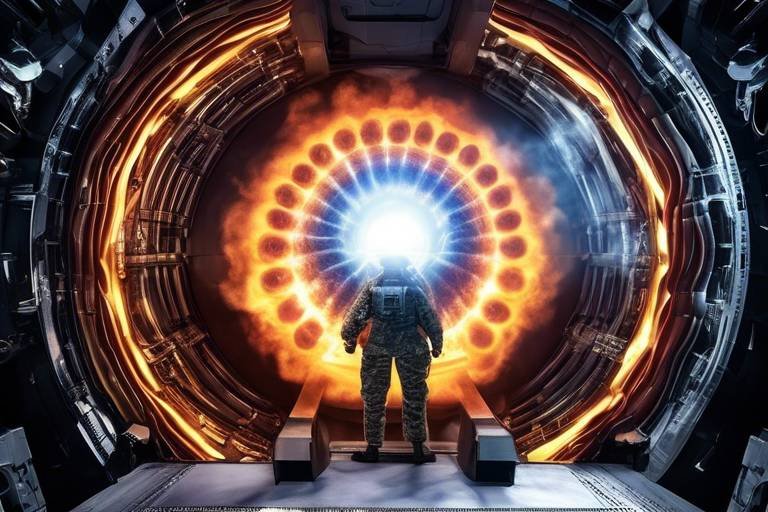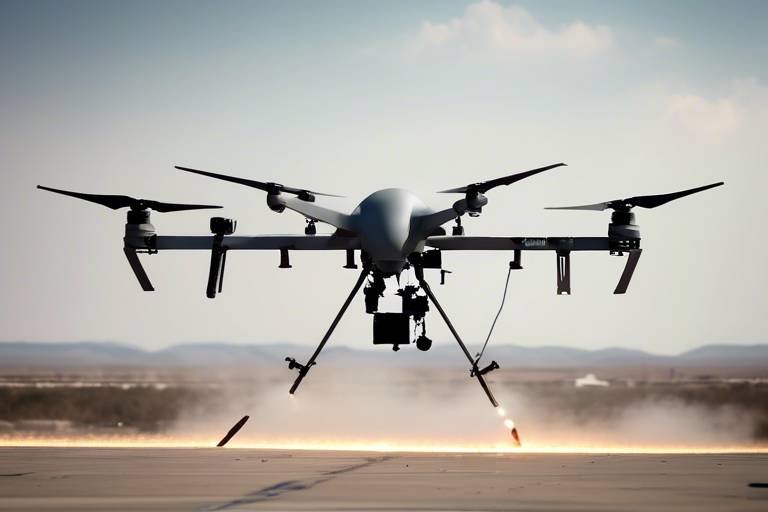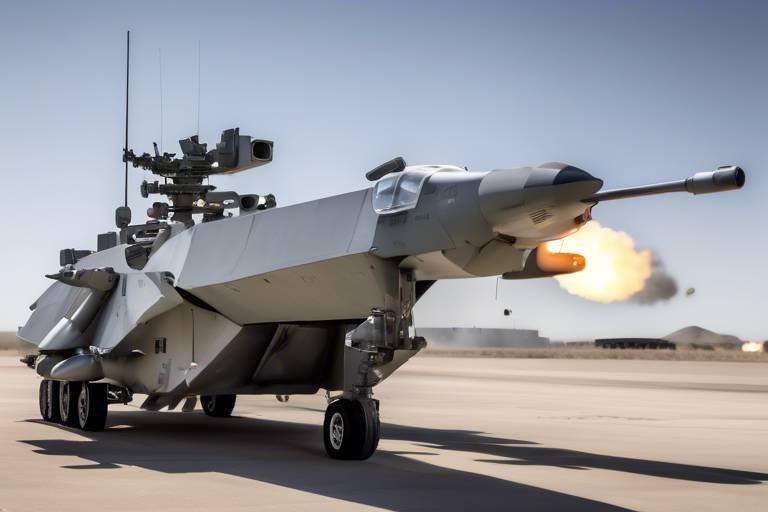The Future of Military Power - Fusion Energy and Defense
As we stand at the precipice of a new era in military technology, the integration of fusion energy into defense systems is not just a possibility; it is a burgeoning reality that promises to redefine global military power dynamics. Imagine a world where armed forces are not constrained by traditional energy sources, where naval vessels glide through the seas powered by clean, virtually limitless energy, and where remote military bases can operate independently without the logistical nightmares of fuel supply chains. This is the vision that fusion energy offers, and it is a vision that is quickly moving from science fiction into tangible applications.
The allure of fusion energy lies in its potential to provide a clean and sustainable energy source that can fuel advanced weaponry and enhance operational capabilities. Unlike fossil fuels, which contribute to environmental degradation and geopolitical tensions, fusion energy generates power through the same processes that fuel the sun—combining light atomic nuclei to form heavier ones, releasing vast amounts of energy in the process. This means that military operations could not only become more efficient but also align with global sustainability goals, creating a more harmonious relationship between defense and environmental stewardship.
Fusion energy holds the promise of revolutionizing military power by providing a nearly limitless and clean energy source, enabling advanced weaponry and enhanced operational capabilities for armed forces around the globe. With the ability to generate energy on-demand, military forces could deploy systems that are less reliant on traditional fuel sources, reducing their carbon footprint and enhancing their operational flexibility. The implications of this shift are profound, as nations could potentially engage in military operations without the same concerns over fuel logistics that have historically hampered effectiveness.
Recent breakthroughs in fusion research have accelerated the development of practical applications for military use, including compact reactors and energy systems that can be deployed in various defense scenarios. These advancements are not just theoretical; they are being tested and refined in laboratories around the world, with scientists and engineers working tirelessly to bring fusion technology from the drawing board to the battlefield. The compact nature of these reactors means they can be integrated into existing military infrastructure, providing a seamless transition to this new energy paradigm.
Fusion energy can be applied in multiple military contexts, from powering naval vessels to providing energy for remote bases, enhancing operational efficiency and reducing logistical challenges. Consider a naval fleet powered by fusion reactors: these ships could operate for extended periods without the need for refueling, allowing them to maintain a persistent presence in critical areas of operation. Moreover, remote bases equipped with fusion energy systems could function autonomously, freeing up supply chains and reducing vulnerability to attacks on fuel convoys.
Implementing fusion energy in defense operations can significantly reduce the carbon footprint of military activities, aligning with global sustainability goals while maintaining strategic advantages in various operational theaters. By transitioning to fusion energy, militaries can not only enhance their operational capabilities but also position themselves as leaders in the fight against climate change. This dual benefit creates a compelling case for the adoption of fusion technology in defense.
The long-term cost savings associated with fusion energy can lead to more efficient defense budgets, allowing nations to allocate resources towards advanced technologies and personnel training. While the initial investment in fusion technology may be substantial, the operational savings over time could be monumental. Imagine a future where military budgets are not drained by fuel costs but instead redirected towards innovation and improvement of defense capabilities.
The integration of fusion energy into military capabilities could shift the balance of power among nations, prompting new arms races and strategic alliances based on energy resources and technological superiority. Nations that successfully harness fusion energy may find themselves at a significant advantage, leading to potential geopolitical tensions as other countries scramble to keep pace. This shift could redefine alliances, as countries with access to fusion technology may emerge as new leaders on the global stage.
Despite its promise, several challenges remain in the development and deployment of fusion energy for military purposes, including technological hurdles, funding issues, and geopolitical considerations. The complexity of fusion technology requires significant investment and collaboration across various sectors, making it a daunting task for many nations. Additionally, the geopolitical landscape complicates matters, as nations may be hesitant to share advancements in fusion technology for fear of losing their strategic edge.
The use of fusion energy in military applications raises important regulatory and ethical questions, necessitating international dialogue to establish guidelines that ensure responsible and peaceful use of this powerful technology. As with any powerful tool, the potential for misuse exists, and it is crucial that nations come together to create frameworks that promote safety and security.
Looking ahead, the future of fusion energy in military applications appears promising, with ongoing research and development paving the way for innovative solutions that could reshape defense strategies worldwide. As nations invest in this technology, we may witness a transformation in how military power is projected, fundamentally altering the landscape of global defense.
- What is fusion energy? Fusion energy is the process of combining light atomic nuclei to form heavier ones, releasing a tremendous amount of energy in the process. It is the same process that powers the sun.
- How could fusion energy impact military operations? By providing a clean and nearly limitless energy source, fusion energy could enhance operational capabilities, reduce logistical challenges, and decrease the carbon footprint of military activities.
- What are the challenges of implementing fusion energy in defense? Challenges include technological hurdles, funding issues, and regulatory and ethical considerations that require international dialogue.
- Will fusion energy lead to new arms races? The integration of fusion energy into military capabilities could shift the balance of power, potentially leading to new arms races and strategic alliances based on energy resources.

The Promise of Fusion Energy
Fusion energy, often hailed as the holy grail of power generation, has the potential to completely transform military capabilities across the globe. Imagine a world where military forces are no longer tethered to fossil fuels or traditional energy sources. Instead, they could harness the power of the stars right here on Earth! This nearly limitless and clean energy source could redefine what it means to be a powerful nation in the modern age.
At its core, fusion energy is about merging atomic nuclei to release energy, much like the processes that fuel our sun. The promise of this technology lies in its ability to provide a sustainable energy solution that could power advanced weaponry, naval vessels, and even entire military bases. With fusion reactors, armed forces could operate with enhanced efficiency, reducing their reliance on extensive fuel logistics and minimizing their environmental impact.
Moreover, the implications of fusion energy extend beyond just operational capabilities. The strategic advantages it offers could reshape the landscape of global military power. Countries that successfully integrate fusion technology into their defense systems could gain a significant edge over their adversaries. This could lead to a new era of military strategy, where energy independence becomes as crucial as technological superiority.
But what does this mean for the future? The integration of fusion energy into military operations could result in:
- Enhanced Mobility: Military units could deploy rapidly without the need for fuel resupply.
- Increased Sustainability: A significant reduction in carbon emissions aligns military operations with global sustainability goals.
- Cost Efficiency: Long-term savings on fuel could be redirected towards advanced technologies and personnel training.
In conclusion, the promise of fusion energy is not just a technological advancement; it represents a fundamental shift in how military power can be harnessed and sustained. As nations vie for dominance in this new energy frontier, the race to develop and implement fusion technology could redefine military strategies for decades to come.
- What is fusion energy? Fusion energy is the process of combining atomic nuclei to release energy, similar to the reactions that power the sun.
- How could fusion energy benefit the military? It could provide a sustainable, limitless energy source for advanced weaponry and operational capabilities, reducing reliance on traditional fuel sources.
- Are there any environmental benefits? Yes, fusion energy produces minimal carbon emissions, aligning military operations with global sustainability goals.

In recent years, the realm of fusion energy has witnessed remarkable strides that could change the landscape of military power forever. Imagine a world where armed forces operate with a clean, virtually limitless energy source, all thanks to groundbreaking advancements in fusion technology. These innovations aren't just theoretical; they are becoming practical realities that could redefine how military operations are conducted globally.
One of the most exciting developments is the creation of compact fusion reactors. These miniaturized power plants can be deployed in various military scenarios, from powering naval vessels to supplying energy for remote bases. The potential for these reactors is enormous, as they can provide energy without the logistical nightmares associated with traditional fuel supply chains. Picture a naval fleet running on fusion energy, eliminating the need for frequent refueling stops and allowing for longer missions without the hassle of resupplying.
Moreover, advancements in superconducting materials have significantly improved the efficiency of fusion reactions. By utilizing these materials, scientists have been able to create stronger magnetic fields that can contain the hot plasma necessary for fusion. This means that reactors can operate at higher temperatures and pressures, leading to more energy being produced from less fuel. The implications for military applications are staggering, as enhanced energy output can support advanced weapon systems and sophisticated defense technologies.
Another notable advancement is the integration of artificial intelligence (AI) in fusion research. AI algorithms are being employed to optimize reactor operations, predict maintenance needs, and even simulate fusion reactions under various conditions. This not only accelerates the research process but also ensures that the reactors are operating at peak efficiency, which is crucial for military applications where reliability is paramount.
Furthermore, international collaborations are on the rise, with nations pooling resources and expertise to accelerate fusion research. Projects like ITER (International Thermonuclear Experimental Reactor) stand as a testament to the global commitment to harnessing fusion energy. Such collaborations not only enhance technological advancements but also pave the way for standardized protocols that can be crucial for military applications. By working together, countries can mitigate the risks associated with the proliferation of fusion technology while maximizing its benefits.
To illustrate the advancements in fusion technology, consider the following table that outlines key developments and their potential military applications:
| Advancement | Description | Military Application |
|---|---|---|
| Compact Fusion Reactors | Miniaturized reactors designed for easy deployment | Powering naval vessels and remote bases |
| Superconducting Materials | Materials that enhance magnetic confinement | Increased energy output for advanced weapon systems |
| Artificial Intelligence | AI algorithms for optimizing reactor operations | Predictive maintenance and operational efficiency |
| International Collaborations | Joint projects like ITER for shared research | Standardized protocols for military applications |
As we delve deeper into the future of military power, it is evident that the advancements in fusion technology are not just exciting; they are essential. The potential for these innovations to enhance military capabilities while promoting sustainability is a game changer. Imagine a defense system that not only operates efficiently but also aligns with global sustainability goals. The fusion revolution is not just on the horizon; it is here, and it is poised to transform the very fabric of military operations.
- What is fusion energy? Fusion energy is the process of combining two light atomic nuclei to form a heavier nucleus, releasing a significant amount of energy in the process.
- How does fusion energy differ from fission energy? Fusion energy combines nuclei, while fission energy splits them. Fusion is generally cleaner and produces less radioactive waste.
- What are the challenges of implementing fusion technology in the military? Key challenges include technological hurdles, funding issues, and the need for regulatory frameworks to ensure safe usage.
- Can fusion energy be used in civilian applications? Absolutely! Fusion energy has potential applications in power generation for civilian use, providing a sustainable energy source for the future.

When we think about the future of military operations, the integration of fusion energy stands out as a game-changer. Imagine a world where military vessels and aircraft are powered by an energy source that is not only abundant but also incredibly clean. Fusion energy, the same process that powers the sun, has the potential to provide armed forces with a near-limitless supply of energy, fundamentally altering how they operate on land, sea, and air.
One of the most promising applications of fusion energy in the military arena is its potential to power naval vessels. Traditional naval ships rely heavily on fossil fuels, which not only contribute to greenhouse gas emissions but also create logistical challenges in terms of supply and storage. With fusion reactors onboard, ships could travel longer distances without the need for frequent refueling, enhancing their operational range and reducing the risk of vulnerabilities associated with fuel supply chains. Imagine a fleet of aircraft carriers that can stay at sea for extended periods, conducting missions without the constant worry of running low on fuel. This could redefine naval strategy and tactics, making operations more efficient and less dependent on vulnerable supply lines.
Additionally, fusion energy could provide power to remote military bases. Often, these installations are located in isolated regions where traditional energy sources are either impractical or too costly to maintain. By deploying compact fusion reactors, military bases could become self-sufficient, generating their own energy for everything from communications to weapon systems. This self-sufficiency not only enhances operational readiness but also significantly reduces the carbon footprint associated with military logistics.
Furthermore, the use of fusion energy in unmanned aerial vehicles (UAVs) and drones could revolutionize aerial reconnaissance and combat. Drones powered by fusion energy would have the potential for extended flight times, allowing them to conduct surveillance over vast areas without the need for frequent returns to base. This capability could provide military commanders with real-time intelligence and situational awareness, enhancing decision-making processes on the battlefield.
However, it's important to note that the integration of fusion energy into military applications is not without its challenges. The technology is still in the developmental stage, and significant investments in research and infrastructure are required before it can be deployed effectively. Moreover, the strategic implications of fusion-powered military assets could lead to new dynamics in global military balance, prompting nations to reevaluate their defense strategies and alliances.
In summary, the military applications of fusion energy are vast and varied, promising to enhance operational efficiency, reduce logistical challenges, and minimize environmental impacts. As research continues to advance, the prospect of a fusion-powered military could become a reality, transforming the landscape of defense operations for years to come.
- What is fusion energy? Fusion energy is the process of combining two atomic nuclei to create a heavier nucleus, releasing a significant amount of energy in the process. It is the same reaction that powers the sun.
- How can fusion energy benefit military operations? Fusion energy can provide a nearly limitless and clean energy source for military applications, enhancing operational efficiency, extending the range of naval vessels, and powering remote bases.
- What are the challenges associated with implementing fusion energy in the military? Some challenges include technological hurdles, funding issues, and the need for international dialogue on regulatory and ethical considerations.

In an era where environmental concerns are at the forefront of global discussions, the military is not exempt from the push towards sustainability. Fusion energy presents a groundbreaking opportunity for armed forces to operate in a more environmentally friendly manner. Imagine a world where military operations are powered by a clean, virtually limitless energy source. This is not just a dream; it could soon be a reality with the adoption of fusion technology.
By integrating fusion energy into their operations, military forces can significantly reduce their carbon footprint. Traditional military operations often rely on fossil fuels, which contribute to greenhouse gas emissions and environmental degradation. In contrast, fusion energy generates power without the harmful byproducts associated with combustion. This shift not only aligns with global sustainability goals but also enhances the operational efficiency of defense systems.
Consider the implications of a naval fleet powered by fusion reactors. These vessels would no longer need to refuel frequently, allowing them to remain deployed for extended periods without the logistical challenges associated with fuel supply. This capability could revolutionize naval strategy, enabling faster response times and greater operational reach. Furthermore, remote military bases could benefit from compact fusion reactors, providing a stable energy source that reduces reliance on fuel convoys, which are often vulnerable to attack.
Moreover, the implementation of fusion energy could lead to a more resilient military infrastructure. With a sustainable energy source, defense operations can maintain functionality even in contested environments where traditional supply lines are disrupted. This resilience is crucial for maintaining strategic advantages in various operational theaters.
As we look towards the future, the integration of fusion energy into military operations not only promises to enhance efficiency but also to foster a new era of sustainable defense practices. The potential for reduced environmental impact, coupled with improved operational capabilities, makes fusion energy an attractive option for modern militaries. However, realizing this potential requires significant investment in research and development, as well as international collaboration to address the challenges associated with this transformative energy source.
- What is fusion energy? Fusion energy is the process of combining atomic nuclei to release energy, similar to the reactions that power the sun.
- How does fusion energy benefit military operations? It provides a clean, sustainable energy source that can reduce logistical challenges and enhance operational efficiency.
- Are there any environmental benefits to using fusion energy in the military? Yes, fusion energy significantly lowers the carbon footprint associated with traditional fossil fuel use in military operations.
- What challenges does the military face in implementing fusion energy? Key challenges include technological hurdles, funding issues, and the need for international regulations.

When we think about the future of military operations, it’s essential to consider not just the capabilities that new technologies can provide, but also their cost-effectiveness. Fusion energy stands out as a game-changer in this regard, offering the potential for significant long-term savings. Imagine a world where military bases are powered by a clean, virtually limitless energy source, drastically reducing the need for traditional fuel supplies. This shift could lead to a profound transformation in how defense budgets are allocated.
One of the most compelling aspects of fusion energy is its ability to reduce operational costs over time. Unlike fossil fuels, which are subject to volatile market prices and geopolitical tensions, fusion energy could stabilize energy costs for military operations. This stability allows military planners to forecast budgets more accurately and allocate resources to other critical areas, such as advanced technology development and personnel training. For instance, consider the following benefits:
- Reduced Fuel Dependency: By harnessing fusion energy, militaries would minimize their reliance on imported fuels, thus reducing logistical challenges and vulnerabilities.
- Lower Maintenance Costs: Fusion reactors, once operational, could require less maintenance compared to traditional power sources, leading to further cost savings.
- Enhanced Operational Range: With a reliable energy source at their disposal, military units could operate in remote areas without the constant need for fuel resupply.
To illustrate the potential financial impact of fusion energy on military budgets, consider the following table:
| Cost Category | Traditional Energy Sources | Fusion Energy |
|---|---|---|
| Initial Investment | High due to infrastructure | Moderate, with potential for long-term savings |
| Operational Costs | Variable and often increasing | Stable and predictable |
| Logistical Costs | High due to transport and storage | Significantly reduced |
| Environmental Compliance Costs | Increasing due to regulations | Minimal, as fusion is clean |
In summary, the cost-effectiveness of fusion power in military applications is not just a theoretical concept; it presents a practical opportunity for nations to enhance their defense capabilities while also being fiscally responsible. The initial investment in fusion technology may seem daunting, but the long-term savings and strategic benefits could well outweigh the costs. This approach not only supports military readiness but also aligns with a growing global emphasis on sustainability and environmental stewardship.
- What is fusion energy? Fusion energy is the process of combining two light atomic nuclei to form a heavier nucleus, releasing a significant amount of energy. It is the same process that powers the sun.
- How does fusion energy differ from fission? Fusion combines light elements, while fission splits heavy elements. Fusion produces less radioactive waste and is generally considered safer.
- What are the main challenges in developing fusion energy? Key challenges include achieving and maintaining the high temperatures and pressures required for fusion, as well as the substantial initial investment needed for research and infrastructure.
- Can fusion energy be used in civilian applications? Absolutely! Beyond military uses, fusion energy has the potential to provide clean and abundant energy for civilian power grids.

This article explores the potential impact of fusion energy on military capabilities, examining advancements in technology, strategic implications, and the future landscape of defense systems powered by sustainable energy sources.
Fusion energy holds the potential to revolutionize military power by providing a nearly limitless and clean energy source, enabling advanced weaponry and enhanced operational capabilities for armed forces around the globe.
Recent breakthroughs in fusion research have accelerated the development of practical applications for military use, including compact reactors and energy systems that can be deployed in various defense scenarios.
Fusion energy can be applied in multiple military contexts, from powering naval vessels to providing energy for remote bases, enhancing operational efficiency and reducing logistical challenges.
Implementing fusion energy in defense operations can significantly reduce the carbon footprint of military activities, aligning with global sustainability goals while maintaining strategic advantages in various operational theaters.
The long-term cost savings associated with fusion energy can lead to more efficient defense budgets, allowing nations to allocate resources towards advanced technologies and personnel training.
The integration of fusion energy into military capabilities could shift the balance of power among nations, prompting new arms races and strategic alliances based on energy resources and technological superiority. Imagine a world where nations no longer rely on fossil fuels for their military operations; instead, they harness the power of the stars. This shift could lead to a profound transformation in how countries project military strength.
One significant aspect of this potential shift is the reduction of dependency on traditional energy sources. Countries that successfully develop and deploy fusion technology may find themselves at a strategic advantage, leading to a reconfiguration of alliances and rivalries. For instance, nations that lag in fusion development could face increased vulnerability, potentially leading to a new form of geopolitical tension.
Moreover, the proliferation of fusion technology could also lead to a more democratized distribution of military power. Smaller nations with access to fusion energy could enhance their military capabilities without the need for extensive budgets traditionally associated with large armies. This democratization could disrupt the current military hierarchy, as emerging powers gain the ability to challenge established ones.
The strategic implications of fusion energy extend beyond mere military might. Nations might engage in collaborative efforts to develop and share fusion technology, fostering international partnerships that could enhance global security. However, this collaboration could also lead to tensions, as countries vie for technological supremacy and control over energy resources.
| Potential Outcomes | Implications |
|---|---|
| Increased Military Capability | Smaller nations can enhance their defense without large budgets. |
| New Arms Races | Countries may compete to develop advanced fusion technologies. |
| Strategic Alliances | Nations may form partnerships based on energy resources. |
| Geopolitical Tensions | Disparities in fusion technology access could lead to conflicts. |
As we look to the future, it's clear that fusion energy will not only change the way militaries operate but also challenge our understanding of global power dynamics. The energy landscape is shifting, and with it, the very foundation of military strategy is being redefined.
Despite its promise, several challenges remain in the development and deployment of fusion energy for military purposes, including technological hurdles, funding issues, and geopolitical considerations.
The use of fusion energy in military applications raises important regulatory and ethical questions, necessitating international dialogue to establish guidelines that ensure responsible and peaceful use of this powerful technology.
Looking ahead, the future of fusion energy in military applications appears promising, with ongoing research and development paving the way for innovative solutions that could reshape defense strategies worldwide.
- What is fusion energy? Fusion energy is the process of combining two light atomic nuclei to form a heavier nucleus, releasing a significant amount of energy in the process.
- How could fusion energy impact military operations? Fusion energy could provide a nearly limitless and clean power source, enhancing military capabilities while reducing dependency on fossil fuels.
- What challenges does fusion energy face in military applications? Challenges include technological hurdles, funding issues, and the need for regulatory and ethical guidelines.
- Will fusion energy lead to new arms races? Yes, the competition for fusion technology could spark new arms races and shift global military balances.

While the allure of fusion energy in military applications is undeniable, the journey from concept to reality is fraught with challenges. First and foremost, the technological hurdles cannot be overlooked. Developing a compact fusion reactor that is both efficient and reliable is akin to trying to harness the sun in a bottle—it's a monumental task that requires significant breakthroughs in physics and engineering.
Moreover, the funding issues present another layer of complexity. Governments around the world are often caught in a tug-of-war between allocating budgets for immediate defense needs versus investing in long-term research like fusion energy. This can lead to a situation where promising technologies languish due to lack of financial support. Imagine trying to build a spaceship with just enough money to buy a high-end telescope; it just won’t get off the ground!
Geopolitical considerations also play a critical role in the implementation of fusion energy in military contexts. Nations may be hesitant to share advancements in fusion technology due to fears of espionage or military imbalance. The very nature of military power is often tied to energy resources, and any shift in how those resources are generated could lead to new tensions and conflicts. For instance, countries with advanced fusion technology could find themselves in a position of power, potentially leading to an arms race not just in weaponry, but in energy capabilities.
Additionally, the regulatory landscape surrounding fusion energy is still in its infancy. With the potential for fusion technology to be used in military applications, there is an urgent need for international dialogue to address regulatory and ethical questions. Establishing guidelines that ensure the responsible use of fusion energy is crucial. Without such regulations, we risk entering a realm where the technology could be misused, leading to unintended consequences that could destabilize global security.
Lastly, we must consider the cultural and institutional resistance to change within military organizations. Traditional energy sources like fossil fuels have been the backbone of military logistics for decades. Transitioning to a radically different energy paradigm will require not just new technologies, but also a shift in mindset. It’s like trying to convince a seasoned sailor to trade in their trusty sailboat for a high-tech jet ski—there’s a lot of skepticism and reluctance to embrace something unfamiliar.
In conclusion, while the challenges to implementing fusion energy in military applications are significant, they are not insurmountable. With dedicated research, international cooperation, and a willingness to adapt, the dream of a sustainable and powerful military future powered by fusion energy could very well become a reality.
- What is fusion energy? Fusion energy is the process of combining two light atomic nuclei to form a heavier nucleus, releasing a significant amount of energy in the process. It is the same reaction that powers the sun.
- Why is fusion energy important for the military? Fusion energy offers a nearly limitless and clean energy source, which can enhance military capabilities, reduce logistical challenges, and align with sustainability goals.
- What are the main challenges to implementing fusion energy in military applications? The main challenges include technological hurdles, funding issues, geopolitical considerations, regulatory and ethical concerns, and cultural resistance within military organizations.
- How can international cooperation help in overcoming these challenges? International cooperation can facilitate knowledge sharing, establish regulatory frameworks, and promote peaceful applications of fusion technology, thereby enhancing global security.

As we venture into the promising realm of fusion energy for military applications, it is crucial to address the regulatory and ethical considerations that accompany this powerful technology. The implications of harnessing fusion energy for defense purposes extend far beyond mere technical challenges; they touch on fundamental issues of international security, environmental responsibility, and human rights. In an era where technological advancements can significantly alter the balance of power, the question arises: how do we ensure that these developments are used responsibly and ethically?
One of the primary challenges is establishing a comprehensive regulatory framework that governs the use of fusion energy in military contexts. This framework must address various aspects, including:
- Safety Standards: Ensuring that fusion reactors are designed and operated with the utmost safety to prevent accidents that could have catastrophic consequences.
- Environmental Impact: Assessing the potential ecological effects of fusion energy production and its deployment in military operations.
- Non-Proliferation: Preventing the misuse of fusion technology for the development of advanced weaponry that could exacerbate global tensions.
Furthermore, ethical considerations must also play a prominent role in discussions about fusion energy in defense. The military's quest for energy independence should not come at the cost of global stability or ethical governance. This brings us to the importance of international dialogue. Countries must come together to establish guidelines that ensure the peaceful use of fusion technology, which could otherwise lead to a new arms race fueled by energy resources.
To illustrate the potential ethical dilemmas, consider the following scenarios:
| Scenario | Potential Ethical Dilemma |
|---|---|
| Deployment of Fusion-Powered Weapons | Could lead to an escalation of military conflicts due to perceived threats from advanced capabilities. |
| Use of Fusion Energy in Combat Zones | Risks harming civilian populations and infrastructure if not managed responsibly. |
| Energy Resource Wars | May result in geopolitical tensions as nations vie for control over fusion technology. |
Ultimately, the journey towards integrating fusion energy into military operations must be navigated with caution. The potential benefits are immense, but they must be weighed against the risks and ethical implications. Engaging in transparent discussions and fostering international cooperation will be vital in ensuring that fusion energy enhances global security rather than undermining it.
- What is fusion energy? Fusion energy is a form of energy generated by fusing atomic nuclei, which releases a significant amount of energy, similar to the processes that power the sun.
- How can fusion energy be used in the military? Fusion energy can power advanced military technologies, such as naval vessels and remote bases, providing a sustainable and efficient energy source.
- What are the regulatory challenges associated with fusion energy? Regulatory challenges include establishing safety standards, addressing environmental impacts, and preventing the proliferation of fusion technology for weaponization.
- Why are ethical considerations important in military fusion energy? Ethical considerations are crucial to ensure that the deployment of fusion energy does not lead to increased military tensions or harm to civilian populations.

The future of fusion energy in military applications is not just a distant dream; it’s rapidly becoming a tangible reality. The ongoing research and development in this field are paving the way for innovative solutions that could fundamentally reshape defense strategies worldwide. Imagine a battlefield where energy is no longer a limiting factor, where military operations can run continuously without the logistical nightmares of fuel supply chains. This is the vision that fusion energy holds for the future of defense.
One of the most exciting prospects is the potential for compact fusion reactors that can be deployed on naval vessels or at remote bases. These reactors could provide a constant and reliable power source, enabling advanced weaponry systems and sophisticated technology that require significant energy inputs. The ability to harness fusion energy could lead to the development of new classes of military hardware, including fully electric ships and aircraft that are not only more efficient but also less dependent on traditional fuel sources.
Moreover, the integration of fusion energy into defense operations could enhance strategic mobility. Armed forces could operate in more remote locations without the need for extensive supply lines, which are often vulnerable to disruption. This flexibility could allow for rapid deployment and response in crisis situations, giving nations a significant tactical advantage. The idea of a self-sustaining military base powered by fusion energy is no longer just science fiction; it’s becoming a feasible concept that could transform how military operations are conducted.
However, the path forward is not without challenges. As we look ahead, we must consider the ethical implications of using such powerful technology in military applications. There will be a need for international dialogue to establish guidelines that ensure the responsible use of fusion energy. The potential for fusion to become a new arms race cannot be ignored, and it is crucial that nations come together to discuss the implications of this technology on global security.
In summary, the future prospects for fusion energy in defense are incredibly promising. With the right investments in research and development, and a commitment to ethical considerations, fusion energy could revolutionize military capabilities. As we stand on the brink of this new frontier, it is essential that we approach it with caution, ensuring that the benefits of fusion energy are harnessed for peace and security rather than conflict.
- What is fusion energy? Fusion energy is the process of combining two light atomic nuclei to form a heavier nucleus, releasing a significant amount of energy in the process. This is the same reaction that powers the sun.
- How can fusion energy benefit the military? Fusion energy can provide a nearly limitless and clean power source, enhancing operational capabilities, reducing logistical challenges, and allowing for advanced military technologies.
- What are the challenges of implementing fusion energy in defense? Key challenges include technological hurdles, funding issues, and the need for international regulations to ensure responsible use.
- Is fusion energy safe for military applications? While fusion energy has the potential to be safer than traditional nuclear energy, it still requires careful consideration of ethical and regulatory frameworks to prevent misuse.
Frequently Asked Questions
- What is fusion energy and why is it important for the military?
Fusion energy is a form of power generated by fusing atomic nuclei, which releases a tremendous amount of energy. It's important for the military because it offers a nearly limitless and clean energy source, potentially transforming military operations by powering advanced technologies and enhancing operational capabilities.
- How can fusion energy improve military capabilities?
Fusion energy can improve military capabilities by providing a reliable power source for advanced weaponry, naval vessels, and remote bases. This leads to enhanced operational efficiency, reduced logistical challenges, and the ability to conduct missions in energy-intensive environments without relying on traditional fuel sources.
- What advancements have been made in fusion technology recently?
Recent advancements in fusion technology include the development of compact reactors and energy systems that can be deployed in various defense scenarios. These breakthroughs have accelerated research, making practical applications for military use more attainable than ever before.
- Can fusion energy help reduce the military's carbon footprint?
Absolutely! Implementing fusion energy in defense operations can significantly lower the carbon footprint of military activities. This aligns with global sustainability goals while maintaining strategic advantages in various operational theaters, allowing militaries to operate more responsibly.
- What are the cost implications of using fusion energy in defense?
The long-term cost savings associated with fusion energy can lead to more efficient defense budgets. By reducing dependency on traditional fuel sources, nations can allocate resources to advanced technologies, personnel training, and overall military readiness.
- How might fusion energy impact the global military balance?
The integration of fusion energy into military capabilities could shift the balance of power among nations. This may prompt new arms races and strategic alliances based on energy resources and technological superiority, changing the dynamics of global defense strategies.
- What challenges does fusion energy face in military applications?
Despite its potential, fusion energy faces several challenges, including technological hurdles, funding issues, and geopolitical considerations. These factors must be addressed to fully realize the benefits of fusion energy in military contexts.
- Are there ethical concerns regarding the use of fusion energy in the military?
Yes, the use of fusion energy in military applications raises important regulatory and ethical questions. It necessitates international dialogue to establish guidelines that ensure responsible and peaceful use of this powerful technology, preventing misuse and fostering global cooperation.
- What does the future hold for fusion energy in defense?
The future of fusion energy in military applications looks promising. Ongoing research and development are paving the way for innovative solutions that could reshape defense strategies worldwide, making militaries more efficient and sustainable.


















